Code for Australia
Research project
and Content Strategy
Code for Australia
Research project
and Content Strategy
Overview
Code for Australia are a Civic Tech organisation. They want to bring people and governments closer together to make beautiful, accessible and human-centred technology.
Their flagship program, the Fellowship, embeds a team of 3 (typically two developers and a designer) inside a Government department for 6 months, to work towards uncovering user needs and create prototypes of potential solutions. Their aim is to show government departments new ways of working.
The brief
Conduct user research to identify:
- How well the information layout and content of the site was meeting user needs?
- Areas where additional resources could be provided.
Timeframe: 2.5 weeks
Budget: $0 budget
Audience: Managers working in government departments and organisations across all three levels of government; Federal, State and Local.
Overview
Code for Australia are a Civic Tech organisation. They want to bring people and governments closer together to make beautiful, accessible and human-centred technology.
Their flagship program, the Fellowship, embeds a team of 3 (typically two developers and a designer) inside a Government department for 6 months, to work towards uncovering user needs and create prototypes of potential solutions. Their aim is to show government departments new ways of working.
The brief
Conduct user research to identify:
- How well the information layout and content of the site was meeting user needs?
- Areas where additional resources could be provided.
Timeframe: 2.5 weeks
Budget: $0 budget
Audience: Managers working in government departments and organisations across all three levels of government; Federal, State and Local.
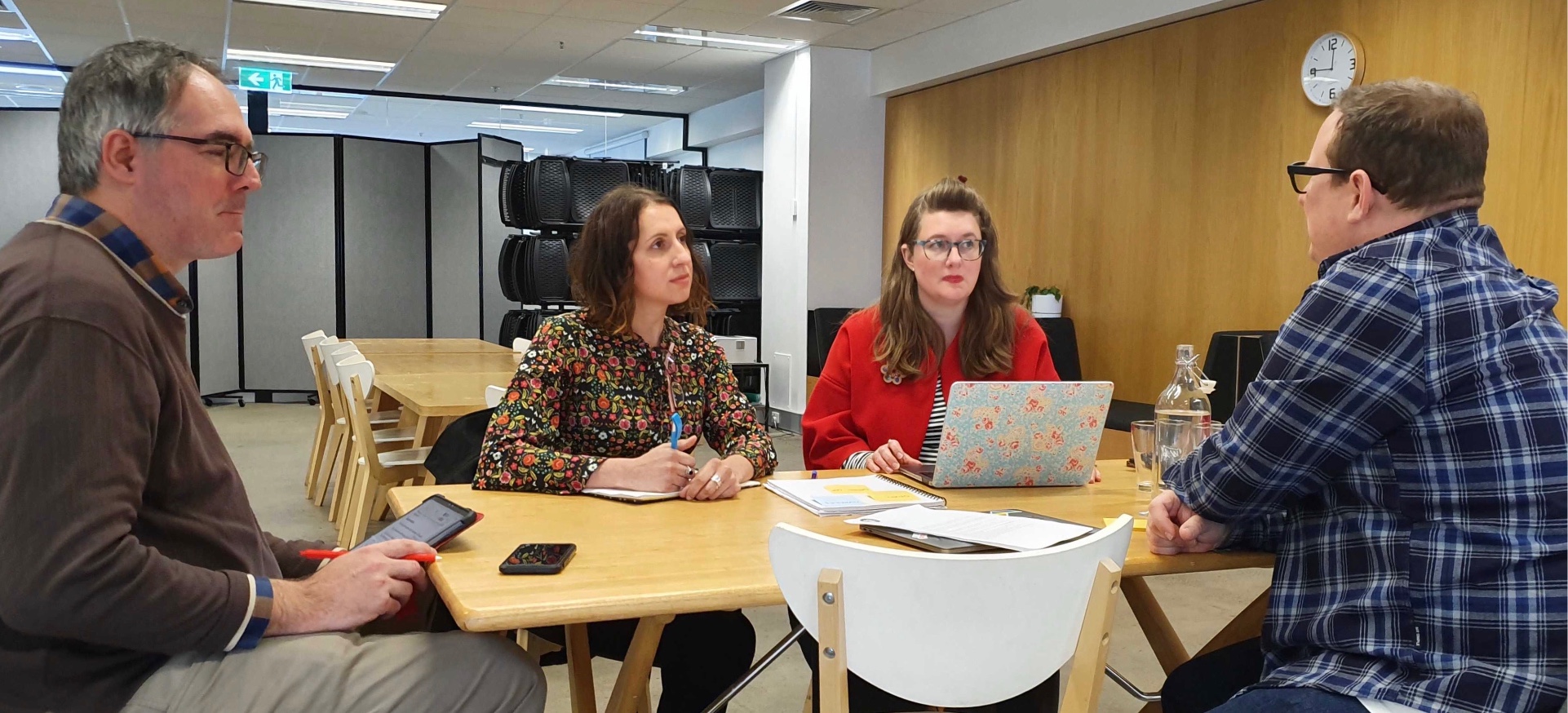
Our Team (left to right): Jonathan Broome, Rebekah Mifsud, Claire Gee interviewing Matt Sawkill, Managing Director of Code for Australia
Our Team (left to right): Jonathan Broome, Rebekah Mifsud, Claire Gee interviewing Matt Sawkill, Managing Director of Code for Australia
First up, we developed a team charter outlining:
- Our responsibilities
- How we would communicate
- Handle any disagreements.
Together we formulated a research plan so that we could hit the ground running in our short time frame.
Stakeholder Interviews and Secondary Research
I conducted the stakeholder interviews with:
- Matt Sawkill - Managing Director Code for Australia
- Alvaro Maz - Co-founder of Code for Australia
- Stacey “Murph” Murphy - Current Fellow of Code for Australia
We researched Code for Australia’s market and competitors.
We found:
Code for Australia wanted to scale their influence
- making a difference is more important than making a making a lot of profit.
Code for Australia’s “Fellowship” model is radically different for government partners of all kinds. There are challenges for government folk with the model.
Code for Australia are one of around 30 similar organisations all over the world, inspired by the original “Code for America”. While the folk at Code for Australia felt they were unique in Australia, there were other “civic tech” players in the Australian government space.
There can be a mismatch between what the government organisation expect and what the Fellows believed they are there to do. Fellows can have trouble getting time with people in the organisation they are embedded in.
First up, we developed a team charter outlining:
- Our responsibilities
- How we would communicate
- Handle any disagreements.
Together we formulated a research plan so that we could hit the ground running in our short time frame.
Stakeholder Interviews and Secondary Research
I conducted the stakeholder interviews with:
- Matt Sawkill - Managing Director Code for Australia
- Alvaro Maz - Co-founder of Code for Australia
- Stacey “Murph” Murphy - Current Fellow of Code for Australia
We researched Code for Australia’s market and competitors.
We found:
Code for Australia wanted to scale their influence - making a difference is more important than making a making a lot of profit.
Code for Australia’s “Fellowship” model is radically different for government partners of all kinds. There are challenges for government folk with the model.
Code for Australia are one of around 30 similar organisations all over the world, inspired by the original “Code for America”. While the folk at Code for Australia felt they were unique in Australia, there were other “civic tech” players in the Australian government space.
There can be a mismatch between what the government organisation expect and what the Fellows believed they are there to do. Fellows can have trouble getting time with people in the organisation they are embedded in.
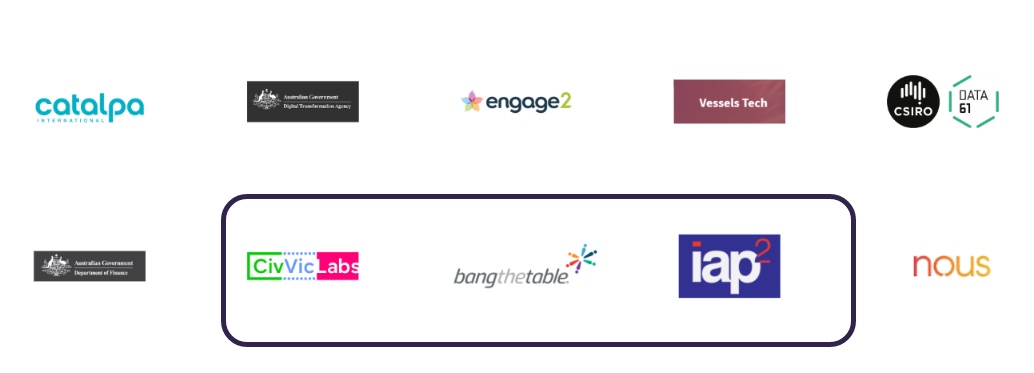
Our user interviews identified three Civic Tech organisations (highlighted) as alternatives to Code for Australia. However, the most likely alternative to Code for Australia was “business as usual” ie. Working with businesses from the pre-approved government procurement list.
Our user interviews identified three Civic Tech organisations (highlighted) as alternatives to Code for Australia. However, the most likely alternative to Code for Australia was “business as usual” ie. Working with businesses from the pre-approved government procurement list.
Primary Research
Survey
We created an anonymous survey and asked Code for Australia to send it previous government partners.
We wanted to know:
- How they had first heard of Code for Australia?
- What it took to set up the Fellowship? What triggered it,? What alternatives they considered?
- How they prepared their department or organisation?
- How the Fellowship went and how did it change their org.? If it did?
- Did they look at the website? At what stage?
Primary Research
Survey
We created an anonymous survey and asked Code for Australia to send it previous government partners.
We wanted to know:
- How they had first heard of Code for Australia?
- What it took to set up the Fellowship? What triggered it,? What alternatives they considered?
- How they prepared their department or organisation?
- How the Fellowship went and how did it change their org.? If it did?
- Did they look at the website? At what stage?
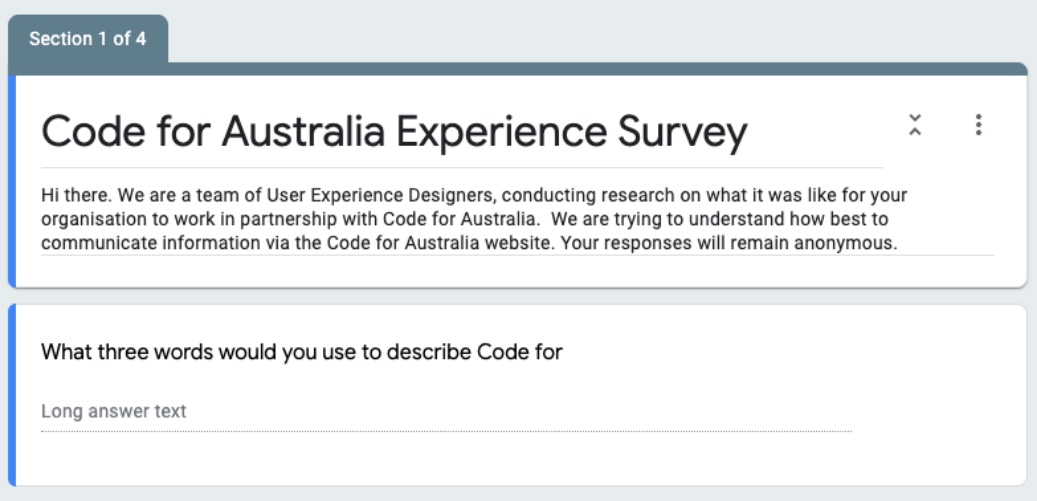
The Results
They were overwhelming positive:
- All had recommended Code for Australia to another department or organisation.
- All had seen permanent changes to their organisations and they way they functioned as a result.
The Results
They were overwhelming positive:
- All had recommended Code for Australia to another department or organisation.
- All had seen permanent changes to their organisations and they way they functioned as a result.
“Our organisation is now willing to explore new delivery models, self organised developer-led projects”
“Our organisation is now willing to explore new delivery models, self organised developer-led projects”
“Our organisation is now willing to explore new delivery models, self organised developer-led projects”
They reinforced how difficult it was to work outside ‘usual government practices’ and all described different, complicated ways they set up the Fellowship, to comply with regulatory and budget guidelines.
They reinforced how difficult it was to work outside ‘usual government practices’ and all described different, complicated ways they set up the Fellowship, to comply with regulatory and budget guidelines.
“We could have prepared our employees better, we needed to provide more exposure”
“We could have prepared our employees better, we needed to provide more exposure”
“We could have prepared our employees better, we needed to provide more exposure”
Challenges:
The short timeframe did not allow for a lot of responses. We gathered good insights but would have liked a much larger sample given more time.
Challenges
The short timeframe did not allow for a lot of responses. We gathered good insights but would have liked a much larger sample given more time.
User Interviews and Contextual Inquiries
We conducted user interviews with:
- 7 government managers
- Across Local and State Government and Government funded organisations
- From Victoria, South Australia and the ACT
These 7 people were from:
- The CSIRO, ACT
- Place and Urban Transport - Department of Transport, Vic
- Housing and Infrastructure - Health and Human Services, Vic.
- Department of Health, Vic
- Department of Education, SA
- City of Melbourne, Vic.
- City of Glen Eira, Vic
We asked them:
- How decisions are made in their departments?
- About their budget and regulatory constraints.
- What information would decision makers need to see before signing off on a partnership?
- Their preferences regarding getting in touch with Code for Australia.
User Interviews and Contextual Inquiries
We conducted user interviews with:
- 7 government managers
- Across Local and State Government and Government funded organisations
- From Victoria, South Australia and the ACT
These 7 people were from:
- The CSIRO, ACT
- Place and Urban Transport - Department of Transport, Vic
- Housing and Infrastructure - Health and Human Services, Vic.
- Department of Health, Vic
- Department of Education, SA
- City of Melbourne, Vic.
- City of Glen Eira, Vic
We asked them:
- How decisions are made in their departments?
- About their budget and regulatory constraints.
- What information would decision makers need to see before signing off on a partnership?
- Their preferences regarding getting in touch with Code for Australia.

5/7 people users had never had any contact with Code for Australia so we introduced them to the website for a Contextual Inquiry.
Government managers have quite a lot to say about government processes and regulatory frameworks. People like to talk about the challenges they face in their work, and the things that make their jobs distinct from others,
5/7 people users had never had any contact with Code for Australia so we introduced them to the website for a Contextual Inquiry.
Government managers have quite a lot to say about government processes and regulatory frameworks. People like to talk about the challenges they face in their work, and the things that make their jobs distinct from others,
The scenario given was:
- A colleague has recommended Code for Australia.
- Look on the website for the information that you would need to find, to consider working with Code for Australia.
- Look for your preferred way to get in touch.
Some of these sessions were conducted in person, while several were conducted as remote video interviews, using Zoom and screen sharing to watch and record what the users were looking at while they browsed the site.
The scenario given was:
- A colleague has recommended
Code for Australia. - Look on the website for the information that you would need to find, to consider working with Code for Australia.
- Look for your preferred way to get in touch.
Some of these sessions were conducted in person, while several were conducted as remote video interviews, using Zoom and screen sharing to watch and record what the users were looking at while they browsed the site.
Card Sorting
Card Sorting
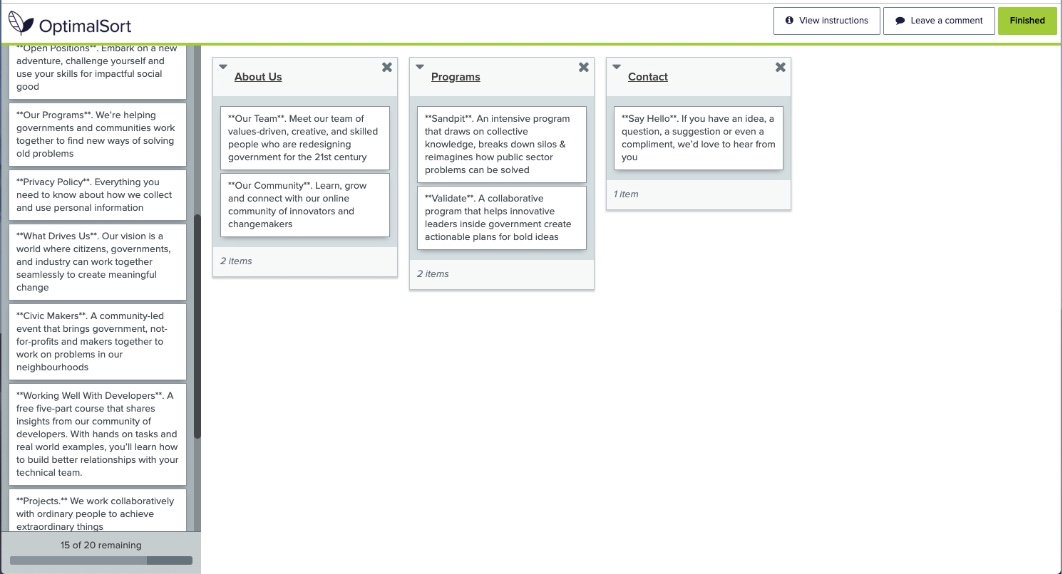
We sent out a remote card sort to our users, populated with content from the current site. We asked them to group the cards in a way that they felt made sense, and to name them as they wished.
Challenges
The short timeframe did not allow for a lot of responses. We started to see some grouping trends emerge, but would have liked a much larger sample given more time.
We sent out a remote card sort to our users, populated with content from the current site. We asked them to group the cards in a way that they felt made sense, and to name them as they wished.
Challenges
The short timeframe did not allow for a lot of responses. We started to see some grouping trends emerge, but would have liked a much larger sample given more time.
Synthesis
Synthesis
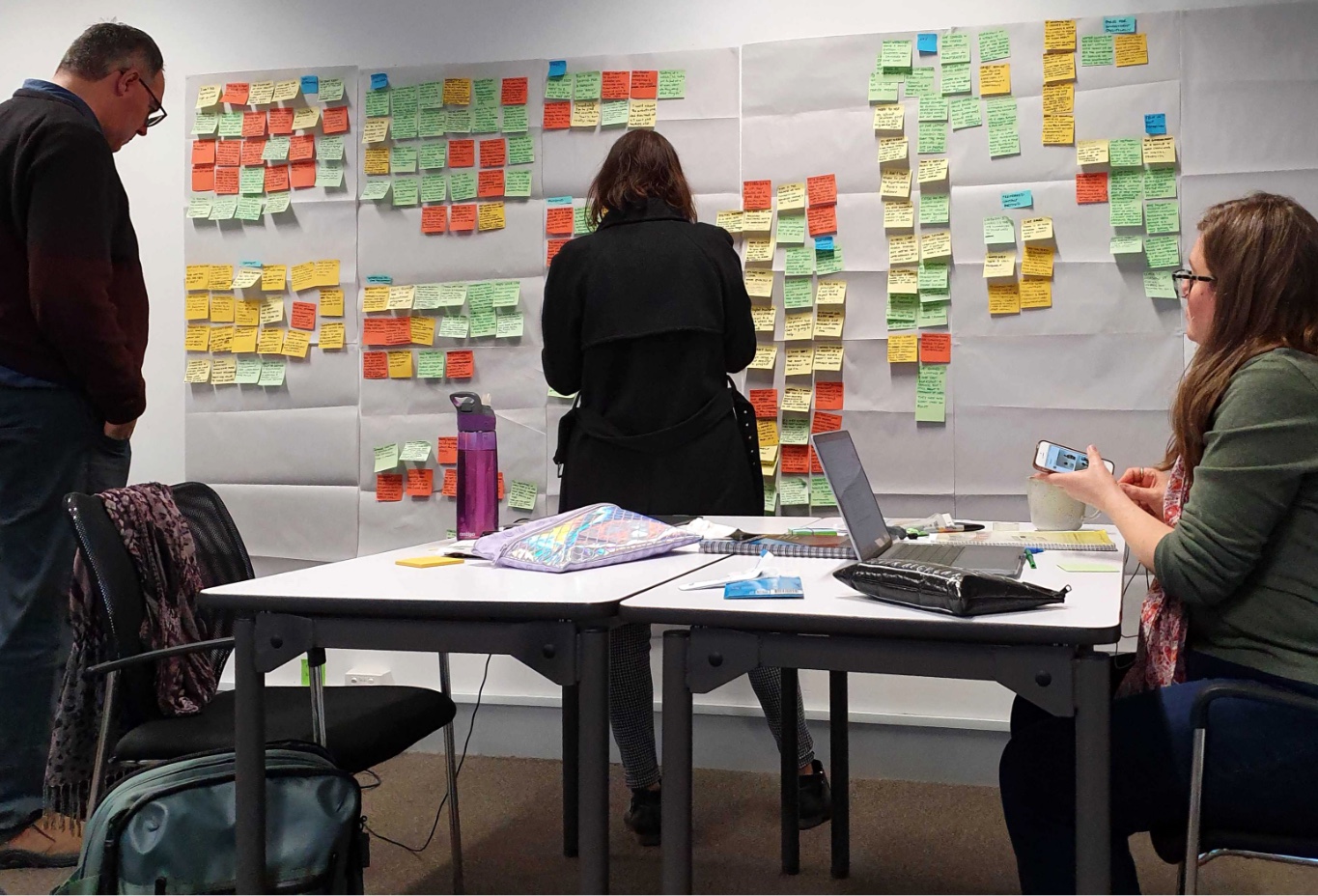
Affinity Mapping
We arranged the insights that we had collected from our users into trends on our affinity map. The affinity map groups helped us inform our priorities for changes to the website.
Affinity Mapping
We arranged the insights that we had collected from our users into trends on our affinity map. The affinity map groups helped us inform our priorities for changes to the website.
“Value for us isn’t getting the fellowship, value for us is in getting a product built from the fellowship”
“Value for us isn’t getting the fellowship, value for us is in getting a product built from the fellowship”
“Value for us isn’t getting the fellowship, value for us is in getting a product built from the fellowship”
SWOT Analysis
SWOT Analysis
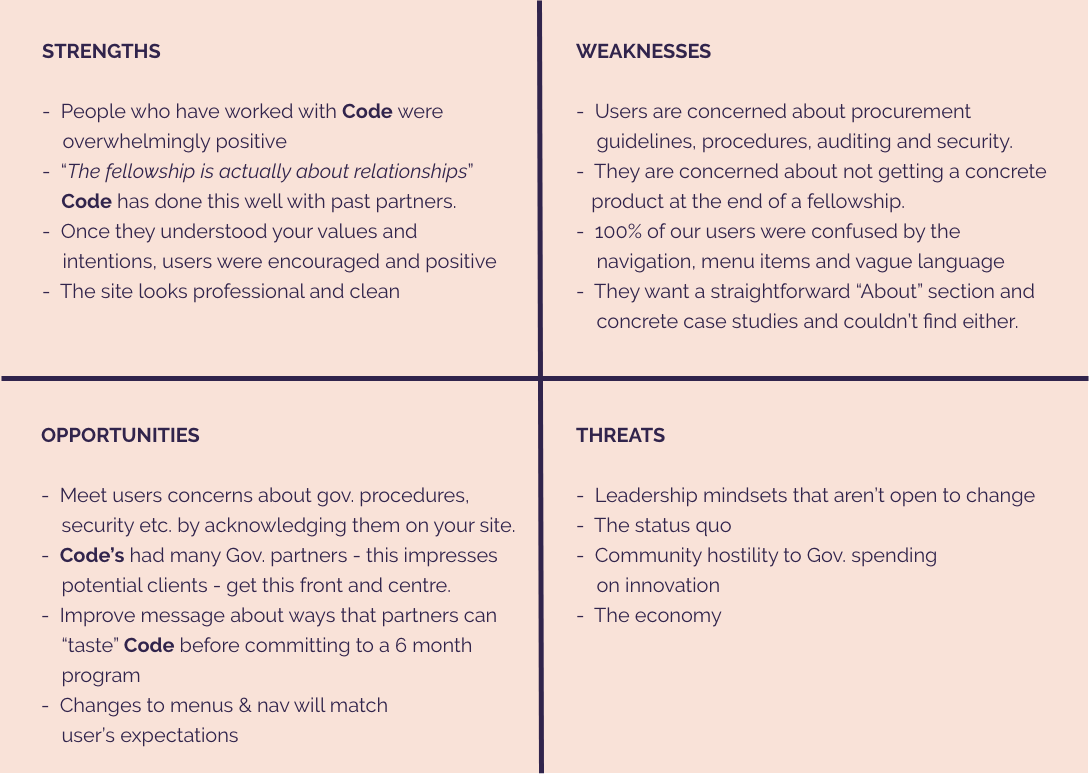
“This website is like an Agatha Christie ‘Who Did It’. It’s giving a clue but it’s not actually telling you what they do”
“Value for us isn’t getting the fellowship, value for us is in getting a product built from the fellowship”
“This website is like an Agatha Christie ‘Who Did It’. It’s giving a clue but it’s not actually telling you what they do”
Code for Australia’s website - before
Code for Australia’s
website - before
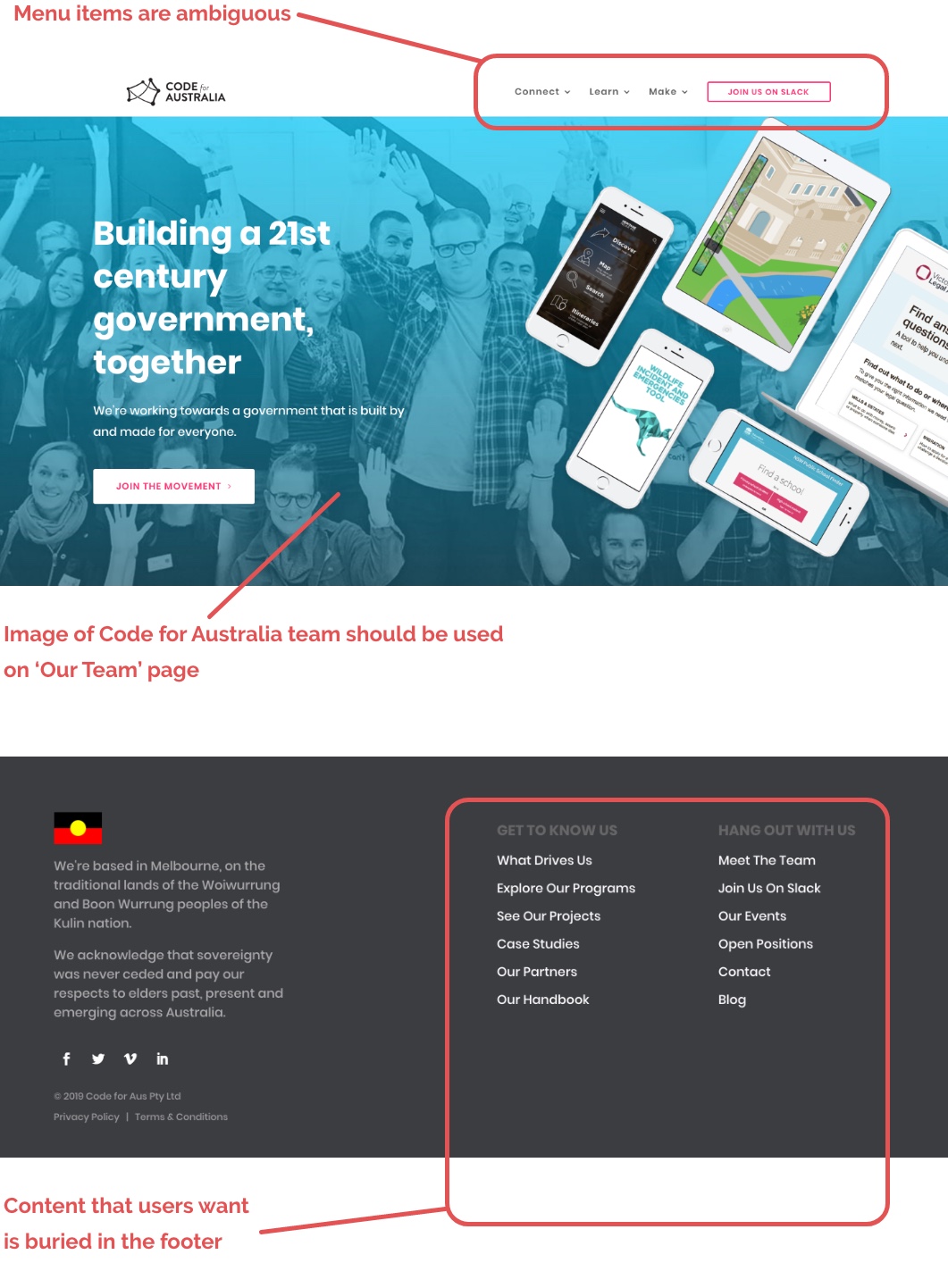
Empathy Mapping
Empathy Mapping

Journey Mapping
Journey Mapping
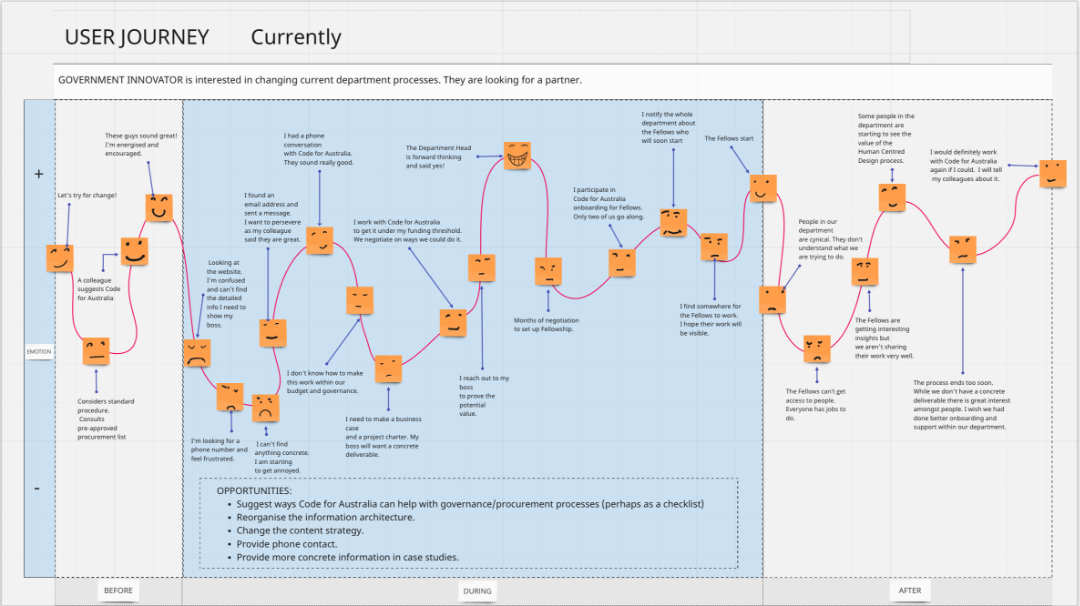
We plotted the complicated process that a government manager would go through to set up a Fellowship with Code for Australia . There are lots of opportunities for improvement.
We plotted the complicated process that a government manager would go through to set up a Fellowship with Code for Australia . There are lots of opportunities for improvement.

Problem Statement
Problem Statement
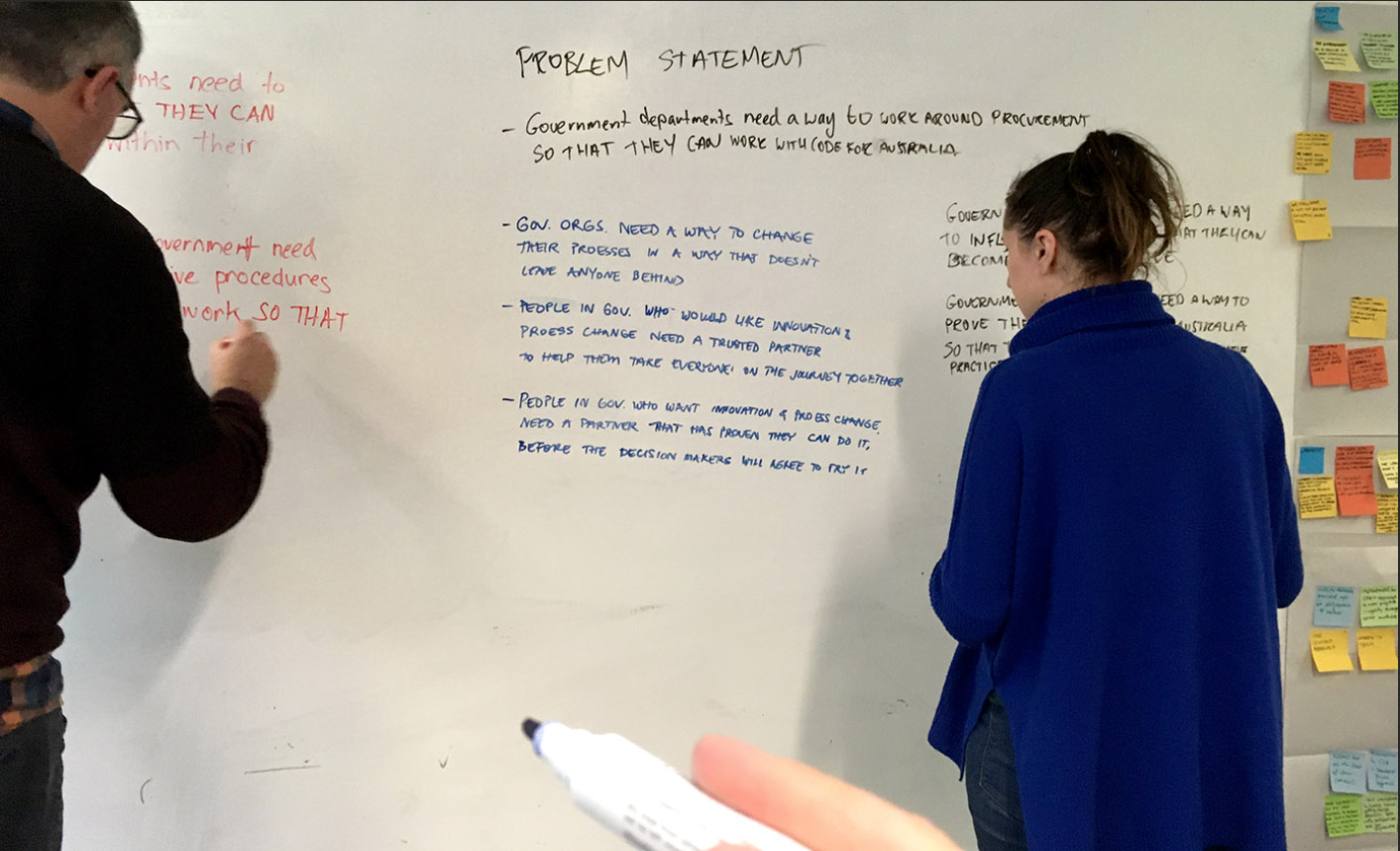
Working together to come up with the perfect problem statement.
Government innovators need a way to prove the value and credibility of Code for Australia’s model so that they can start a partnership
Working together to come up with the perfect problem statement.
Government innovators need a way to prove the value and credibility of Code for Australia’s model so that they can start a partnership
Now that we had defined the problem it was time to work on developing solutions.
Ideation
How Might We…
Help government innovators find the right information about Code for Australia so they can be confident of their value and credibility?
Meet each type of concern government organisations have, with proof of how Code for Australia have managed this constraint?
This became our hypothesis…
We believe that by providing easy to find and relevant information, for government innovators, we will prove the value and credibility of Code for Australia and an understanding about how to partner with them.
We will know this to be true when we see an increase in government folk contacting Code for Australia to talk about partnerships.
Now that we had defined the problem it was time to work on developing solutions.
Ideation
How Might We…
Help government innovators find the right information about Code for Australia so they can be confident of their value and credibility?
Meet each type of concern government organisations have, with proof of how Code for Australia have managed this constraint?
This became our hypothesis…
We believe that by providing easy to find and relevant information, for government innovators, we will prove the value and credibility of Code for Australia and an understanding about how to partner with them.
We will know this to be true when we see an increase in government folk contacting Code for Australia to talk about partnerships.
Solutions
Sitemap
Navigation and menus
- We created a new site map with less ambiguous, more direct language
- We recommeded testing the revised navigation against the current navigation
- Remove ‘Slack’ as a button in the main menu. Some government employees are not officially allowed to use it on government computers, which is where they are most likely to look at the site,
Solutions
Sitemap
Navigation and menus
- We created a new site map with less ambiguous, more direct language
- We recommeded testing the revised navigation against the current navigation
- Remove ‘Slack’ as a button in the main menu. Some government employees are not officially allowed to use it on government computers, which is where they are most likely to look at the site.

Using the trends that started to emerge from our card sort, and the strong feedback from user interviews we created a new sitemap.
Using the trends that started to emerge from our card sort, and the strong feedback from user interviews we created a new sitemap.
Wireframe
Wireframe
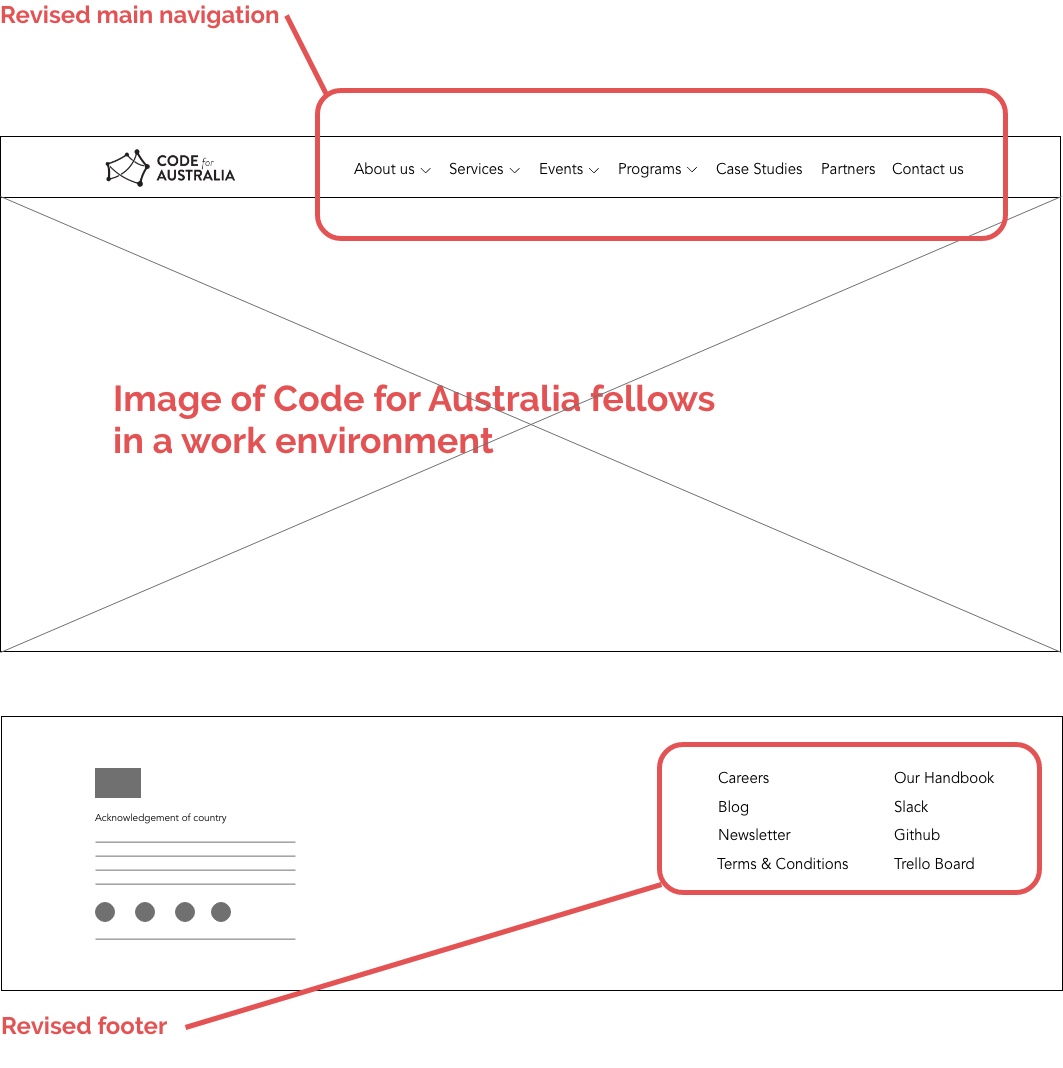
Content recommendations
‘‘'Who we are’ and ‘What we do’ is the first thing users should see on the home page, followed by some Case Studies ( the second thing users look for).
Language
‘The target users are tech aware innovators but government decision makers may not be tech savvy. Don’t alienate then. Explain terms like ‘agile’ and ‘human-centred-design’.
(Both terms came up in user interviews. One user said agile workplaces = hot desks).
Code for Australia’s name confuses some users, further testing is recommended regarding changing the name.
Contact - List a phone number on the website (all users were looking for it)
Restructure case studies to contain:
- The government organisation (add their logo for recognition).
- The challenge
- The solution
- What was delivered?
- Are there measurable outcomes as a result?
Images should reflect users needs. Use photos of the team only on ‘About us’ pages.
Content recommendations
‘‘'Who we are’ and ‘What we do’ is the first thing users should see on the home page, followed by some Case Studies ( the second thing users look for).
Language
‘The target users are tech aware innovators but government decision makers may not be tech savvy. Don’t alienate then. Explain terms like ‘agile’ and ‘human-centred-design’.
(Both terms came up in user interviews. One user said agile workplaces = hot desks).
Code for Australia’s name confuses some users, further testing is recommended regarding changing the name.
Contact - List a phone number on the website (all users were looking for it)
Restructure case studies to contain:
- The government organisation (add their logo for recognition).
- The challenge
- The solution
- What was delivered?
- Are there measurable outcomes as a result?
Images should reflect users needs. Use photos of the team only on ‘About us’ pages.
Content recommendations
‘‘'Who we are’ and ‘What we do’ is the first thing users should see on the home page, followed by some Case Studies ( the second thing users look for).
Language
‘The target users are tech aware innovators but government decision makers may not be tech savvy. Don’t alienate then. Explain terms like ‘agile’ and ‘human-centred-design’.
(Both terms came up in user interviews. One user said agile workplaces = hot desks).
Code for Australia’s name confuses some users, further testing is recommended regarding changing the name.
Contact - List a phone number on the website (all users were looking for it)
Restructure case studies to contain:
- The government organisation (add their logo for recognition).
- The challenge
- The solution
- What was delivered?
- Are there measurable outcomes as a result?
Images should reflect users needs. Use photos of the team only on ‘About us’ pages.
Content recommendations
‘‘'Who we are’ and ‘What we do’ is the first thing users should see on the home page, followed by some Case Studies ( the second thing users look for).
Language
‘The target users are tech aware innovators but government decision makers may not be tech savvy. Don’t alienate then. Explain terms like ‘agile’ and ‘human-centred-design’.
(Both terms came up in user interviews. One user said agile workplaces = hot desks).
Code for Australia’s name confuses some users, further testing is recommended regarding changing the name.
Contact - List a phone number on the website (all users were looking for it)
Restructure case studies to contain:
- The government organisation (add their logo for recognition).
- The challenge
- The solution
- What was delivered?
- Are there measurable outcomes as a result?
Images should reflect users needs. Use photos of the team only on ‘About us’ pages.
Content recommendations
‘‘'Who we are’ and ‘What we do’ is the first thing users should see on the home page, followed by some Case Studies ( the second thing users look for).
Language
‘The target users are tech aware innovators but government decision makers may not be tech savvy. Don’t alienate then. Explain terms like ‘agile’ and ‘human-centred-design’.
(Both terms came up in user interviews. One user said agile workplaces = hot desks).
Code for Australia’s name confuses some users, further testing is recommended regarding changing the name.
Contact - List a phone number on the website (all users were looking for it)
Restructure case studies to contain:
- The government organisation (add their logo for recognition).
- The challenge
- The solution
- What was delivered?
- Are there measurable outcomes as a result?
Images should reflect users needs. Use photos of the team only on ‘About us’ pages.
New content recommendations
A unique Case Study about how Code for Australia set up a Fellowship with a government partner.
Re-write the ‘projects’ section as case studies.
A checklist of government barriers (e.g. competitive procurement procedures, security vetting) and talk about how you can work with government partners to deal with each barrier. This acknowledgement will encourage confidence.
Talk directly about how government organisations could get a ‘taste’ of Code for Australia. Users suggested a strategy where a smaller commitment would not need the same budget procurement process, so a single manager could sign off on a smaller offering, and prove to their department the expertise of Code for Australia,
On-boarding guidelines for the government side of the fellowship program, to combat misalignment of expectations.
Consider creating content for different levels of government.
New content recommendations
A unique Case Study about how Code for Australia set up a Fellowship with a government partner.
Re-write the ‘projects’ section as case studies.
A checklist of government barriers (e.g. competitive procurement procedures, security vetting) and talk about how you can work with government partners to deal with each barrier. This acknowledgement will encourage confidence.
Talk directly about how government organisations could get a ‘taste’ of Code for Australia. Users suggested a strategy where a smaller commitment would not need the same budget procurement process, so a single manager could sign off on a smaller offering, and prove to their department the expertise of Code for Australia,
On-boarding guidelines for the government side of the fellowship program, to combat misalignment of expectations.
Consider creating content for different levels of government.
Outcomes
Our recommendations were well received by Code for Australia. They are planning on implementing some of them soon.
Outcomes
Our recommendations were well received by Code for Australia. They are planning on implementing some of them soon.
My Role
I conducted all of the Stakeholder & User interviews and Contextual Inquiries (over 10 hours worth). This was fabulous practice for me at interviewing - I love it!
I wrote up the SWOT analysis and the final recommendations. I really enjoyed condensing our research insights, findings and ideation into concrete recommendations.
My Role
I conducted all of the Stakeholder & User interviews and Contextual Inquiries (over 10 hours worth). This was fabulous practice for me at interviewing - I love it!
I wrote up the SWOT analysis and the final recommendations. I really enjoyed condensing our research insights, findings and ideation into concrete recommendations.
Challenges/Learnings
Getting access to Government managers was quite a challenge. These users were willing, but not necessarily available in our timeframe.
They were generous with their time once they committed to an interview. The average interview was 1 hour long, even in cases where we tried to cut it short for the user’s sake.
Due to $0 budget, we used the free versions of all the technical tools that we used, and worked around the limits that this created.
I was worried that the client would be unhappy because of how many changes to their website that we recommended. It turned out that they were really pleased to have valuable research and clear directions about what to change. They were surprised with how much we accomplished in 2 1/2 weeks.
Challenges/Learnings
Getting access to Government managers was quite a challenge. These users were willing, but not necessarily available in our timeframe.
They were generous with their time once they committed to an interview. The average interview was 1 hour long, even in cases where we tried to cut it short for the user’s sake.
Due to $0 budget, we used the free versions of all the technical tools that we used, and worked around the limits that this created.
I was worried that the client would be unhappy because of how many changes to their website that we recommended. It turned out that they were really pleased to have valuable research and clear directions about what to change. They were surprised with how much we accomplished in 2 1/2 weeks.